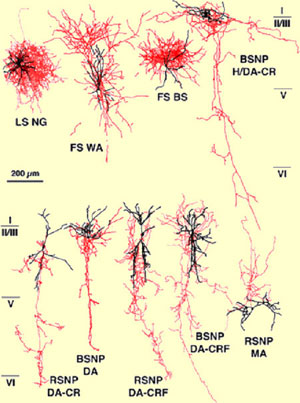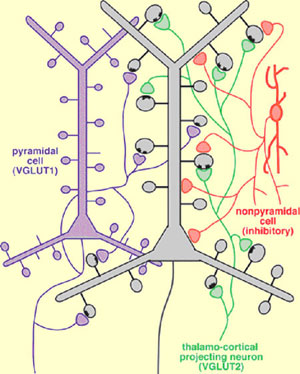| 大脳皮質棘突起への興奮性入力と抑制性入力の二重支配 |
|
大脳皮質機能研究系 大脳神経回路論研究部門
|
大脳皮質の非錐体細胞のターゲットを明らかにする為に、電子顕微鏡を使った3次元再構築法により、非錐体細胞の神経終末が形成するシナプスの構造を前後ともに再構築した。FS細胞2種類、マルチノッチ細胞、ニューログリアフォーム細胞と5個のダブルブーケ細胞の合計9個の非錐体細胞に関して検討した結果、細胞体をターゲットにするものは全体の約半数だけであった。ターゲットのおよそ半数は樹状突起の幹の部分であった。驚く事に、皮質の抑制性神経細胞のターゲット全体の25%−50%のターゲットは棘突起という事があきらかとなった。しかも、それらの棘突起のほとんどに興奮性と思われる第2のシナプスが接着し、二重支配を受けている非常に特殊な棘突起をターゲットにしていた。次に、この二重支配棘突起のもう一つのシナプスである興奮性の求心性神経終末はどこから由来しているのかを明らかにする為に、VGLUTをマーカーにした免疫組織化学法を使って証明した。その結果、二重支配を受けている棘突起を支配している興奮性神経終末はVGLUT2陽性を示す視床由来の興奮性神経終末である事がわかった。すなわち、視床由来の興奮性の信号のごく一部(10%程度)は、皮質の非錐体細胞によって選択的に抑制されているのである。ヒゲの刺激で、この二重支配をうける棘突起の数が皮質に増える事が知られている事から、機能的に重要な働きをしているものと考える。また、神経細胞の末端への抑制も、とても重要な抑制機能を担っている事を示唆する結果であると考えている。実は、この抑制作用の方が、癲癇発作を押さえる上でより重要な働きをしているという事も報告されている。
Kubota Y, Hatada S, Kondo S, Karube F, Kawaguchi Y (2007) Neocortical Inhibitory Terminals Innervate Dendritic Spines Targeted by Thalamocortical Afferents. J. Neurosci. 27, 1139-1150.
|
| |
 |
 |
|
大脳皮質の様々な種類の非錐体細胞。この9個の非錐体細胞の軸索終末を電子顕微鏡で観察し、3次元再構築したところ、ターゲットの約1/3〜1/2が棘突起である事が判明した。しかも、その棘突起は、もう一つの入力として興奮性シナプスを受けていた。
|
大脳皮質の非錐体細胞の神経終末の多くが棘突起を神経支配し、その棘突起は視床由来の興奮性神経終末の支配を受けている事がわかった。しかも、その棘突起は大きなヘッドを持っており、AMPA受容体を発現していた事から、伝達効率の高い興奮性のシナプス入力を受けている事がわかった。皮質の抑制細胞は、視床からの強い入力を、入力部位である棘突起の頭部で、選択的に効率良くブロックしているのであろうと考えられる。 |
|
| |
| Fast inhibition in the cortex is gated primarily at GABAergic synapses formed by local interneurons onto postsynaptic targets. Although GABAergic inputs to the somata and axon initial segments of neocortical pyramidal neurons are associated with direct inhibition of action potential generation, the role of GABAergic inputs to distal dendritic segments, including spines, is less well characterized. Because a significant proportion of inhibitory input occurs on distal dendrites and spines, it will be important to determine whether these GABAergic synapses are formed selectively by certain classes of presynaptic cells onto specific postsynaptic elements. By electron microscopic observations of synapses formed by different subtypes of nonpyramidal cells, we found that a surprisingly large fraction (33.4 +- 9.3%) of terminals formed symmetrical synaptic junctions onto a subset of cortical spines that were mostly coinnervated by an asymmetrical terminal. Using VGLUT1 and VGLUT2 isoform of the glutamate vesicular transporter immunohistochemistry, we found that the double-innervated spines selectively received thalamocortical afferents expressing the VGLUT2 but almost never intracortical inputs expressing the VGLUT1. When comparing the volumes of differentially innervated spines and their synaptic junction areas, we found that spines innervated by VGLUT2-positive terminal were significantly larger than spines innervated by VGLUT1-positive terminal and that these spines had larger, and more often perforated, synapses than those of spines innervated by VGLUT1-positive afferent. These results demonstrate that inhibitory inputs to pyramidal cell spines may preferentially reduce thalamocortical rather than intracortical synaptic transmission and are therefore positioned to selectively gate extracortical information. This shunting inhibition might be important for epileptic seizure, because decreased inhibition onto dendrites promotes epileptic seizures. |

